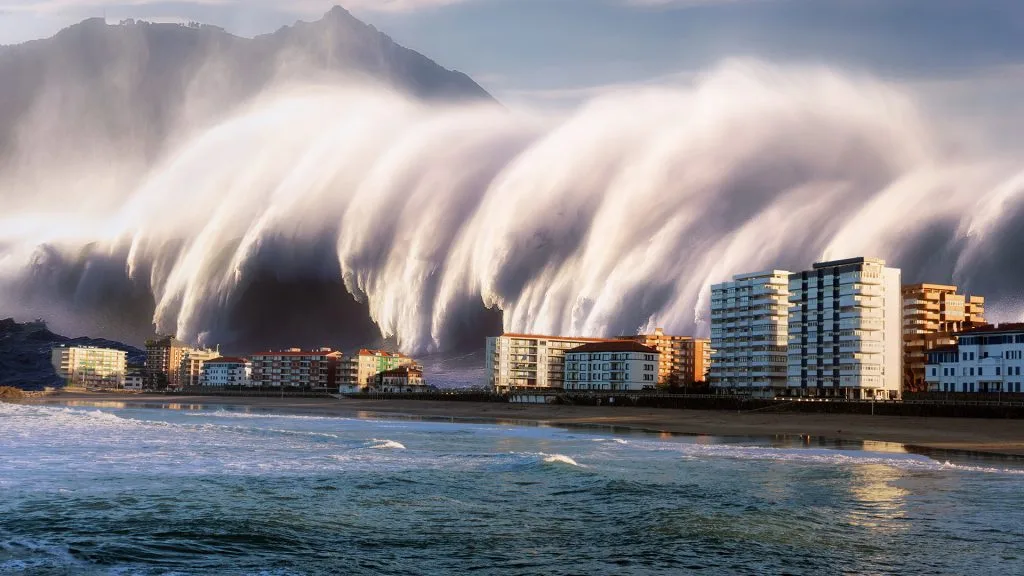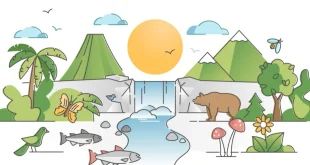
Introduction
A tsunami is a sequence of ocean waves caused by large-scale disturbances, such as volcanic eruptions, earthquakes, or landslides, that move large amounts of water.
It is also known as tidal waves, are waves that can cause local water waves. Although tides and tsunamis both produce these waves, it can cause the water to move considerably farther inland, making it look like a very powerful and high tide, known as a tsunami wave.
It is a derivative of the Japanese word soo-NAH-mee. Its meaning in Japanese is harbor wave. Since in Japanese alphabets, there is no ‘T’. So, when spelled the initial ‘T’ is regularly silent which fits with the phonologic rules of English.
How does Tsunami happen?
It can be caused by diverse sources, including volcanic eruptions, earthquakes, landslides, glacier calving, and man-made disturbances above or below water. It is typically caused by the movement of a large volume of water or disturbance in the sea. Earthquakes, landslides, ice calving, volcanic eruptions, and, in rare cases, meteorites and nuclear tests can all lead to water displacement and trigger a tsunami. Earthquakes are the key cause of tsunamis that happen globally.

Causes of a Tsunami
Caused by Earthquake
It can occur when the seafloor suddenly distorts and displaces the water spread over the surface vertically. Tectonic earthquakes are a type of earthquake that is associated with the distortion of the Earth’s crust. When these earthquakes happen under the sea, the water above the deformed area is displaced from its balanced state.
Because of the movement of the vertical component, it can be produced when thrust faults associated with convergent or destructive plate boundaries move suddenly, resulting in water displacement.
These have a long wavelength and a small wave height offshore, which is why they are ignored at sea, creating just a small swell about 12 inches above the usual sea level. When they enter narrow water, they rise in height, a process known as wave shoaling. It can occur in any tidal state and a coast can be flooded even if there is a low tide.
Some examples of earthquake-caused tsunamis are, The Valdivia earthquake in 1960, the Alaska earthquake in 1964, and in the Indian Ocean in 2004.
Caused by Landslides
Landslides cause dislocations mostly along the shallower sections of the coastline, and the range of large landslides that hit the water is indeterminate. Water in enclosed inlets and lakes is disturbed as a result, but no landslide large enough to cause a transoceanic tsunami has ever happened in recorded history.
Caused by Meteorological Conditions
A tsunami caused because of meteorological changes is called a meteotsunami. Rapid changes in atmospheric pressure, such as those seen when a front passes through, can relocate water bodies enough to cause trains of waves with wavelengths the same as a seismic tsunami, but with lower energies.
These are dynamically similar to seismic one, with the exemption that in Meteotsunami, the transoceanic scope of substantial seismic ones is absent and that the force that relocates the water is sustained over time, avoiding Meteotsunami from being modeled as occurring promptly.
In spite of their lower energies, they can be strong enough to cause localized damage and loss of life on coastlines where they can be strengthened by resonance.
Major Types
Three basic types occur worldwide as follows;
Local Tsunami
It causes damage near the event that triggered the tsunami. The underwater incidence, which is typically an earthquake that activates a local tsunami, occurs within just over 60 miles of the land damage that results.
Since the time duration between the underwater incidence and the arrival of the tidal wave can be less than an hour and even less than 10 minutes, these tsunamis can be disastrous. Due to less time for sufficient evacuation.
Regional Tsunami
It is described as one that causes damage between 100 and 1,000 kilometers from the source of the origination of the tsunami. Outside the 1,000-kilometer border, more limited damages will occur in some cases.
These have a meaningfully longer warning time than local ones, arriving between one to three hours after generating an incident. Within a 1,000-kilometer radius, even one to three hours might not be enough for people to evacuate safely.
Distant Tsunami
Ocean-wide or Teletsunami, is caused by a strong and disastrous incidence that occurs more than 1,000 kilometers away from land. It may seem to be a local tsunami at first, but it spreads through vast bands of the ocean basin.
It allows more time to leave, but it also occupies a wider area and is more likely to cause damage.
Effects of Tsunami
The impact on a coastline can differ from slight to disastrous. The physical features of the seismic event that caused the tsunami, its distance from the origin point, duration, and, finally the structure of the depth of water in oceans along the coast that the tsunami is approaching, all affect the consequences.
Some of the catastrophic effects on animals, nature, and humans.
Destruction
- When a huge wave hits land, energy and water stored in it will be the reason for colossal damage.
- These enforce damage by two mechanisms: the smashing force of a fast-moving flow of water, and the destructive strength of a large volume of water draining off the ground and carrying a large amount of wreckage with it, even with small waves.
- The primary wave of a large tsunami is tremendously high, but it does not cause heavy damage. The huge mass of water in the second wavefront causes major damage, as the sea level continues to rise quickly and floods the coastal region.
- The never-ending crashing water, and the strength of the waves, are the reasons of destruction and death. The huge breaking waves will destroy everything in their way as they hit the shoreline, such as boats, bridges, houses, trees, vehicles, power lines, telephone lines, and just about everything else.
- If the waves have removed the infrastructure at shorelines, they will proceed to local areas for several miles, crushing more houses, trees, vehicles, and other man-made objects.

Deaths
- The cost of human life is one of the most critical consequences since surviving it is almost impossible. It takes the lives of hundreds of thousands of people.
- Before it hits the ground, there is very little caution. When the water starts to flow toward the coast, there is no time to plan an escape pathway.
- People who live in coastal cities and villages do not have plenty of time to escape. The tsunami’s strong force causes sudden death, most usually from sinking. Other causes of death are a breakdown of buildings, electrocution, broken tanks, fires from gas, and floating debris.
Disease
- In affected areas, the spread of waterborne diseases due to polluted drinking water and stagnant flood water. When water is polluted, and stagnant, illnesses like malaria can spread.
- Since it is not easy for people to remain healthy and diseases to be treated in these areas, illnesses and infections spread rapidly, resulting in more deaths.
Environmental Impacts
- Tsunamis not only kill humans, but also wipe out livestock, insects, plants, and natural resources.
- The landscape is also changed by these tidal waves. It displaces plants and trees, as well as animal territories including bird nesting sites.
- Land animals sink and kill, and also kill sea animals when deadly substances are washed away into the sea, poisoning marine life.
- The environmental impacts of it is comprise not just the landscape and animal life, but also affect the human-made elements of the climate.

Some Facts About the Tsunami
- Some zoologists claim that some animals can detect subsonic Rayleigh waves produced by a tsunami or an earthquake. Monitoring their actions may provide an early warning of earthquakes and a tidal wave if done correctly. The proof, on the other hand, is arguable and not usually accepted.
- Approximately, about 80% of these arise in the Pacific Ocean.
- The first wave of the Tsunami is not the strongest, however, the succeeding waves are bigger and stronger.
- If anyone is trapped by a wave, it is better to not swim, instead, must grasp an object and let the wave carry him.
- These can travel through the ocean with the least energy loss.
- An earthquake caused a tsunami in the Indian Ocean with the energy of 23000 atomic bombs in 2004. After the earthquake, 11 countries were crashed by the radiation emitted from the epicenter. The total number of deaths was 283000.
Tsunami Safety
It becomes dangerous when it reaches the land. Its speed decreases from 30 to 20mph when it enters narrow water near seashores. The wavelength decreases, height increases, and the currents strengthen.
Warnings come in various methods. Warning centers broadcast warnings through local television and radio, wireless emergency alerts, weather radios, and social media. They may also be received by outdoor alarms, local officials, text message alerts, and telephone notifications.

It is better to distinguish natural warnings instead of waiting for an official warning. These include strong and long earthquakes, a loud sound similar to train or aeroplane coming from the ocean, a sudden rise or fall in the sea level not associated to the tide. Both official and natural warnings are equally important. One should be prepared to answer quickly to these warnings.
One can move to a safe place by following the clearing signs. If somebody is unable to do so, then he/ she must go to high altitude area or far away from the seashores.
When tidal waves strike land, their height is less than 10 feet, but in some cases, it can exceed 100 feet near origination.
It can come to the shore like a wall of stormy water or a fast-rising flood. Moreover, a huge wave can destroy low-lying coastal areas to a large degree. Rushing water from waves, floods, and rivers is highly powerful. It can wash off everything comes on their way.
Tidal waves are destructive due to their volume and speed. They become more hazardous when they return from the sea carrying objects, people, and debris with them. Therefore, people are advised to stay out of the hazard zones until the conditions come under control.
ARY NEWS shared a news that “Three-metre tsunami recorded at Japan nuclear plant in recent quake” https://arynews.tv/three-metre-tsunami-recorded-japan-nuclear-plant-recent-quake/
 The Climent Respect your roots, Protect your planet
The Climent Respect your roots, Protect your planet
